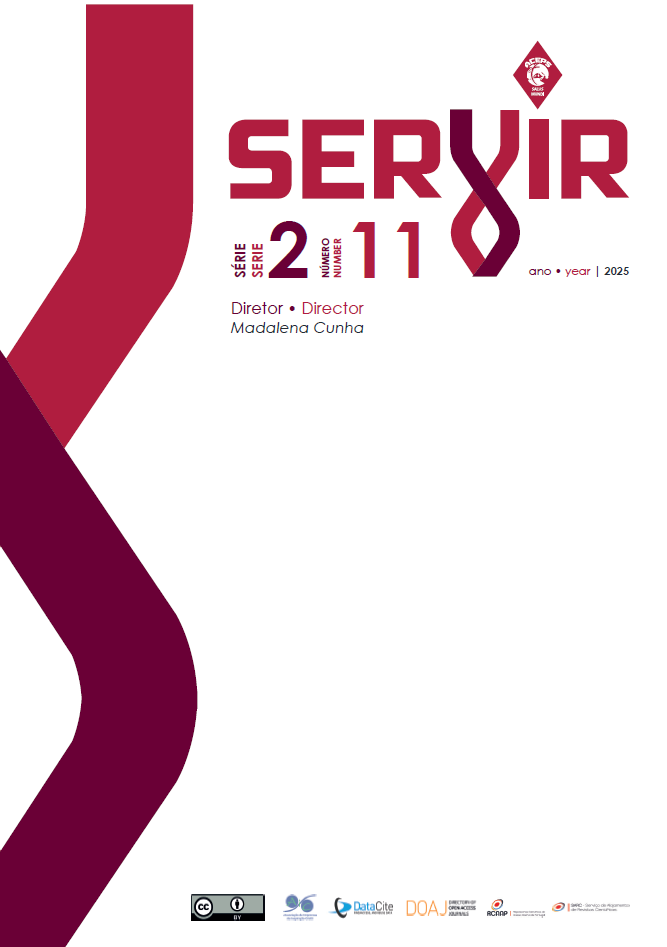Humanitude in Emergency Nursing Care
Experiences in the Insular Context of Cabo Verde
DOI:
https://doi.org/10.48492/servir0211.38770Keywords:
Humanitude Methodology, Nursing, Emergency Services, Critical PatientAbstract
Introduction: Humanitude Methodology (MH), as a concept and relational strategy, is essential in the therapeutic relationship and promotion of excellence in care. which is characterized by the inclusion in nursing interventions of its pillars, that is, the word, the look, the touch and verticality.
Objective/s: To understand the perception of nurses regarding the relevance and consistency of application of MH, in care in Emergency Services (ED) in the island context of Cape Verde (CV).
Methods: Quantitative and descriptive study, using data obtained from the application of the Form “Structured Sequence of Humanitude Care Procedures (SEPCH), (Simões, et al., 2012), to a sample of 12 ED nurses.
Results: The sample constituted 34.28% of the professional universe of the CV ED, mostly female (58.3%=7), between 27 and 31 years old, residing in CV. It was found that in terms of relevance, less than half of the sample, 42.15%, marked “Not applicable”, and 2.2% of the sample considered this strategy “unimportant”. Regarding the consistency of MH application, 39.96% indicated “I always carry out”, but there is 1.5% of the sample, which indicated “I never carry out” these interventions.
Conclusion: In the CV island context, less than half of the nurses in the ED admit to recognizing the relevance and applying MH, and they admit to doing so because they believe that it promotes interpersonal relationships with users and empathy. Training on this topic is suggested, in order to promote the quality of care.
Downloads
References
Barros, A. I. (2021). Humanização dos cuidados de enfermagem em contexto de urgência e emergência. Porto, Portugal: Universidade Católica Portuguesa. Obtido de http://hdl.handle.net/10400.14/34708
Batista, S. C., Capaz, J. N., & Ribeiro, P. C. (2019). O cuidar em humanitude: uma perspetiva confortadora. 60(1-2). Lisboa, Portugal. doi: https://doi.org/10.48492/servir021-2.24492
Fukuyasu, Y., Kataoka, H. U., Honda, M., Iwase, T., Ogawa, H., Sato, M., Watanabe, M., Fujii, C., Wada, J., DeSantis, J., Hojat, M., & Gonnella, J. S. (2021). The effect of Humanitude care methodology on improving empathy: a six-year longitudinal study of medical students in Japan. BMC medical education, 21(1), 316. https://doi.org/10.1186/s12909-021-02773-x
Giang, T. A., Koh, J. E. J., Cheng, L. J., Tang, Q. C., Chua, M. J., Liew, T. M., Wee, S. L., & Yap, P. L. K. (2023). Effects of Humanitude care on people with dementia and caregivers: A scoping review. Journal of clinical nursing, 32(13-14), 2969–2984. https://doi.org/10.1111/jocn.16477
Ordem dos Enfermeiros. (2018). Diário da República. (135), 2.ª, 19360-19364. Portugal.
Pinto, M. d. (2019). Metodologia de cuidado humanitude impacto na redução do burnout dos cuidadores formais numa ERPI. Porto, Portugal. Obtido de http://hdl.handle.net/10400.26/33533
Sato, W., Nakazawa, A., Yoshikawa, S., Kochiyama, T., Honda, M., & Gineste, Y. (2023). Behavioral and neural underpinnings of empathic characteristics in a Humanitude-care expert. Frontiers in medicine, 10, 1059203. https://doi.org/10.3389/fmed.2023.1059203
Simões, M. Salgueiro, N., Rodrigues M. (2012). Cuidar em humanitude: estudo aplicado em cuidados continuados. Revista de Enfermagem Referência, versão impressa. ISSN 0874-0283.
Sumioka, H., Shiomi, M., Honda, M., & Nakazawa, A. (2021). Technical Challenges for Smooth Interaction With Seniors With Dementia: Lessons From Humanitude™. 8. Kyoto, Japan. doi:https://doi.org/10.3389/frobt.2021.650906
Published
How to Cite
Issue
Section
License
Copyright (c) 2025 Izaquel Lopes

This work is licensed under a Creative Commons Attribution 4.0 International License.
In order to promote the free circulation of knowledge, Servir is open access journal. All its content is available and protected under the Creative Commons license (CC BY 4.0).
The journal allows self-archiving in institutional repositories of all versions, which may become immediately available


